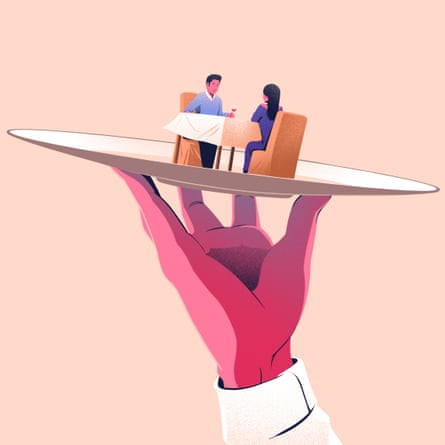February 2020, Britain’s restaurants were reeling. EU-based staff had been sent scurrying home by Brexit, no longer keen to work in a country that gave every impression of not wanting them. The price of imported ingredients was rising, thanks to increased bureaucracy and a weakened pound. Still, restaurateurs told themselves, at least things could hardly get worse.
Enter coronavirus. At times over the past two years the pandemic has looked like it may be an extinction level event for hospitality. All the things initially blamed for the spread of coronavirus – touching, breathing, close quarters with other people – were just the sorts of things that went on in restaurants. They were blamed for not shutting soon enough, despite inadequate government assurances of financial support. Then they were blamed for not reopening fast enough, before being propelled by Rishi Sunak’s “eat out to help out” scheme. After that, they were admonished for reopening too fast, when that measure proved at best premature and at worst foolish in the face of rising case numbers.
Absence makes the heart grow fonder and the stomach rumble louder. Two years on from the first lockdown, after experiencing a world without restaurants, we know what we were missing. Even if you don’t go to restaurants often, you’ll have experienced the tingle of appreciation at being out in the world again, in elegant sociable surroundings, eating food prepared, served and washed up by others. Like the Pompidou Centre for buildings, Covid made the inner workings of restaurants clear. Nobody can feign ignorance about the money, stress and labour that goes into eating out. This new world comes with new rules.
Do right by your tenants
Some of the high-profile closures will be mourned more than others. Tears will flow more freely for Hix than branches of Café Rouge, or Wahlburgers, the latter the actor Mark Wahlberg’s attempt at creating a Covent Garden tourist trap, which barely got going before travel to London stopped and it did, too. “People aren’t coming back to central London five days a week, and I don’t know when tourists will be back,” says Nick Garston, an agent who specialises in restaurant properties. “But the market returned to normal remarkably fast. The big new factor is outdoor space. It’s key to what people are looking for. Before, operators might have turned their nose up at a bit of pavement with a few tables, but now they’ll try to make it work.”
While there were deals to be had during the depths of the pandemic, so far landlords have been reluctant to kick out tenants, even those who have fallen behind on the rent. Bigger agents are reluctant to write down their whole portfolio, while independents mostly recognise the strains restaurants have been under. “If you evict someone, you have a period where you’re not collecting rent and then you have to market the property. You need to do the analysis.”
Offer as many meals as you can
The recent wave of high-profile new cafes in the capital – Deco, Lighthaus, Cecilia, Norman’s – is partly born from a desire to offer a more casual and flexible experience than the traditional three courses. It also lends itself naturally to all-day dining and all-day revenues. Even Gunpowder, contemporary Indian restaurants in London better known for fiery lamb cutlets, is experimenting with breakfast. Dishoom was prescient.
Offer something special
“I think, post-pandemic, people are excited about a heightened dining experience,” says Jeremy Chan, the head chef of St James’s two-Michelin-starred Ikoyi. “People are happy to spend on quality. We do 50 covers at £250 a head. The high earners have saved so much over the past few years they’re ready to splash out.”
Whether business or pleasure, lunch is a time for celebration
“We have seen the return of the business lunch in a big way,” says Russell Norman of Brutto in Clerkenwell. “If you can afford the time and the expense of dining with a colleague or a client – particularly if you have a work expense account – then it seems people are doing that again after a fall, even pre-Covid. It’s very heartening to see a bottle of wine and a few negronis on most of our lunch tables.” The sommeliers agree. “Thursday is the new Friday,” says Joshua Castle, head sommelier at London’s Noble Rot. “There has been a huge uptick of interest in champagne. We thought people would have recalibrated their understanding of markups after so long at home, but it hasn’t happened. Drinkers are trading up and spending more.”
Embrace technology
“Technology has become part of the customer experience now,” says Mital Morar, the founder of the Manchester-based retail and hospitality operation the Store Group. “Covid forced us to move things along so quickly and it’s now embedded in what people expect.” The Sunday app, launched by the founders of the Big Mamma group, has experienced rapid take-up. QR codes are here to stay, at least in casual chains, because they save the staff time – five minutes per table adds up in a busy restaurant – and thereby save the owners money.
Appreciate the small things
The return to dining out has made diners more appreciative of the flourishes restaurants offer beyond the food and drink. “People are loving service,” says Molly Steemson, head of wine at Sessions Arts Club in east London. “All the thoughtful things you don’t get at home – glassware and oyster forks and cutlery.”
Menus to fit the clientele
“We’ve noticed that people weren’t travelling so far to dine out,” says Mary-Ellen McTague, of Campagna at the Creameries. “Pre-pandemic, people were coming from the wider Greater Manchester/Cheshire area, but that just stopped. We had to completely change our business from a tasting menu setup, to being a neighbourhood restaurant serving accessible dishes,” she says. “We have the same ingredients and quality, but totally different delivery.” At the other end of the scale, some have gone the other way, following Marco Pierre White’s rule of putting up prices in tough times.
Book or don’t book. No-shows are not on
Before the pandemic, asking customers to book with a credit card could lead to much clutching of pearls. Now it’s the norm, at least at popular inner-city restaurants. “People are much more committed to their bookings,” says François O’Neill of Maison François in St James’s. “I think they have a greater understanding of how tough things have been for restaurants and the impact of last-minute cancellations or no-shows.” Out of London, the opposite can apply. “Spontaneous dining seems to be back,” says Cecilia Gillies, of Number Eight in Sevenoaks. “Following lockdowns, and having to book months in advance, people are enjoying their freedom and supporting local businesses. We have seen our walk-ins increase dramatically.”

Be mindful
“I’ve noticed most people being very considerate and giving people space and room to pass,” says Jeremy Lee, chef-proprietor at Soho’s Quo Vadis. “There is consideration for those who still choose to wear masks. Cleaning is still a priority.”
With restrictions lifted, some customers are sticking to masks while others couldn’t fling them off fast enough. Some are happy to be rammed in again cheek by jowl while others crave space. Sharing plates have become a more radical suggestion, especially among people who are not in a couple. Some customers are assiduously hand-sanitising, others are back to soap and water (we hope).
“Post-pandemic dining seems to be about contradictions,” says Jacob Kenedy of Bocca di Lupo in central London. “Some customers want staff to wear masks, others are offended by them. Some want to be close and noisy, others want distance and quiet. All seem to want one more drink than before.”
Prepare to pay
“After the VAT and business rates increase in April, prices will be more expensive,” says Hussein Ahmad of Viewpoint Accountants, which specialises in hospitality businesses. “This isn’t the restaurant taking the piss but the reality of increased food and drink costs, staff and overheads. If you want to keep going to your favourite restaurant, be prepared to pay more.”
Appreciate your staff
“Staffing remains a huge problem,” says Nick Garston. “Not just because of the pandemic, but Brexit, too.” The situation might not be as acute as it was during the reopening phase, when Omicron stalked hospitality, but the structural problems remain. For restaurateurs, this means they will have to pay their staff more; costs that will be passed on to consumers.
“We found it hard to get chefs of the right calibre,” says Victor Garvey of Sola in Soho. “But we are getting there, and we are busier than ever.” Eat now; you never know when you might not be able to again.

Comments (…)
Sign in or create your Guardian account to join the discussion